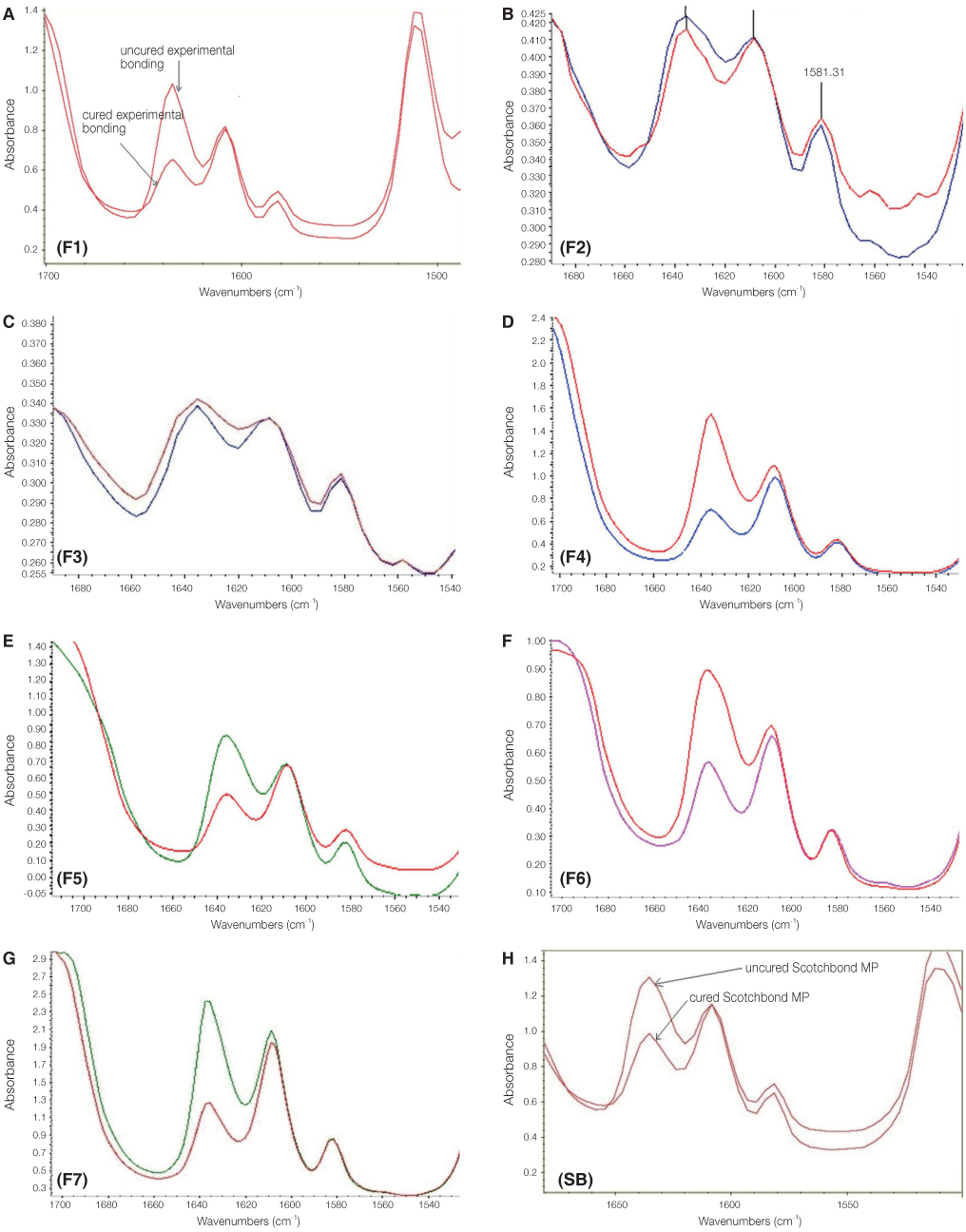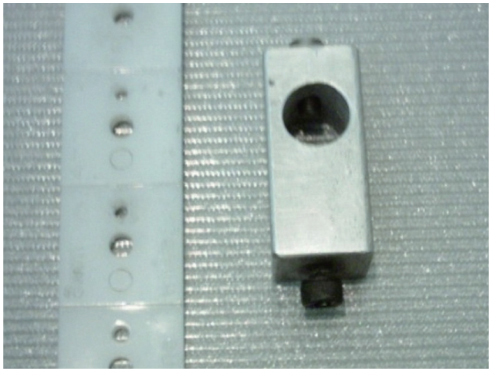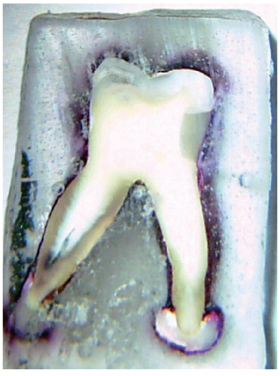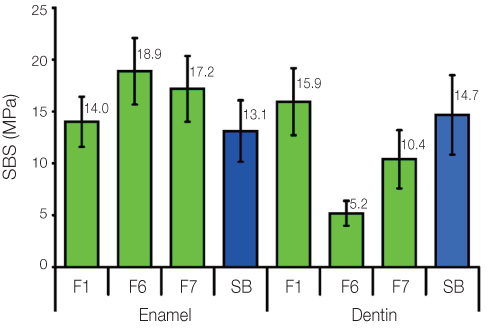J Adv Prosthodont.
2014 Oct;6(5):333-345. 10.4047/jap.2014.6.5.333.
The effects of dentin bonding agent formulas on their polymerization quality, and together with tooth tissues on their microleakage and shear bond strength: an explorative 3-step experiment
- Affiliations
-
- 1Department of Pharmaceutics, School of Pharmacy, Shahid Beheshti University of Medical Sciences, Tehran, Iran.
- 2Iranian Tissue Bank and Research Center, Department of Dental Materials, Faculty of Dentistry, Research Center for Sciences and Technology in Medicine, Tehran University of Medical Sciences, Tehran, Iran.
- 3Pharmacist in private practice, Tehran, Iran.
- 4Iranian Tissue Bank and Research Center, Tehran University of Medical Sciences, Tehran, Iran. v_rakhshan@dentaliau.ac.ir
- 5Department of Dental Anatomy and Morphology, Dental Branch, Islamic Azad University, Tehran, Iran.
- KMID: 2284733
- DOI: http://doi.org/10.4047/jap.2014.6.5.333
Abstract
- PURPOSE
Bonding agents (BA) are the crucial weak link of composite restorations. Since the commercial materials' compositions are not disclosed, studies to formulize the optimum ratios of different components are of value. The aim of this study was to find a proper formula of BAs.
MATERIALS AND METHODS
This explorative experimental in vitro study was composed of 4 different sets of extensive experiments. A commercial BA and 7 experimental formulas were compared in terms of degree of conversion (5 experimental formulas), shear bond strength, mode of failure, and microleakage (3 experimental formulas). Statistical analyses were performed (alpha=.05). The DC of selected formula was tested one year later.
RESULTS
The two-way ANOVA indicated a significant difference between the shear bond strength (SBS) of two tissues (dentin vs. enamel, P=.0001) in a way that dentinal bonds were weaker. However, there was no difference between the four materials (P=.283). The adhesive mode of failure was predominant in all groups. No differences between the microleakage of the four materials at occlusal (P=.788) or gingival (P=.508) sites were detected (Kruskal-Wallis). The Mann-Whitney U test showed a significant difference between the microleakage of all materials (3 experimental formulas and a commercial material) together at the occlusal site versus the gingival site (P=.041).
CONCLUSION
A formula with 62% bisphenol A-glycidyl methacrylate (Bis-GMA), 37% hydroxy ethyl methacrylate (HEMA), 0.3% camphorquinone (CQ), and 0.7% dimethyl-para-toluidine (DMPT) seems a proper formula for mass production. The microleakage and SBS might be respectively higher and lower on dentin compared to enamel.
Keyword
MeSH Terms
Figure
Reference
-
1. Peumans M, Van Meerbeek B, Lambrechts P, Vanherle G. Porcelain veneers: a review of the literature. J Dent. 2000; 28:163–177.2. Magne P, Douglas WH. Cumulative effects of successive restorative procedures on anterior crown flexure: intact versus veneered incisors. Quintessence Int. 2000; 31:5–18.3. Shafiei L, Mojiri P, Ghahraman Y, Rakhshan V. Microleakage of a self-adhesive class v composite on primary and permanent dentitions. J Contemp Dent Pract. 2013; 14:461–467.4. Khosravanifard B, Nemati-Anaraki S, Faraghat S, Sajjadi SH, Rakhshan H, Rakhshan V. Efficacy of 4 surface treatments in increasing the shear bond strength of orthodontic brackets bonded to saliva-contaminated direct composites. Orthod Wave. 2011; 70:65–70.5. Khosravanifard B, Rakhshan V, Saadatmand A. Effects of blood and saliva contamination on shear bond strength of metal orthodontic brackets and evaluating certain methods for reversing the effect of contamination. Orthod Wave. 2010; 69:156–163.6. Jafarzadeh Kashi TS, Erfan M, Rakhshan V, Aghabaigi N, Tabatabaei FS. An in vitro assessment of the effects of three surface treatments on repair bond strength of aged composites. Oper Dent. 2011; 36:608–617.7. Prasanna N, Pallavi Reddy Y, Kavitha S, Lakshmi Narayanan L. Degree of conversion and residual stress of preheated and room-temperature composites. Indian J Dent Res. 2007; 18:173–176.8. Jafarzadeh-Kashi TS, Mirzaii M, Erfan M, Fazel A, Eskandarion S, Rakhshan V. Polymerization behavior and thermal characteristics of two new composites at five temperatures: refrigeration to preheating. J Adv Prosthodont. 2011; 3:216–220.9. Cotti E, Scungio P, Dettori C, Ennas G. Comparison of the Degree of Conversion of Resin Based Endodontic Sealers Using the DSC Technique. Eur J Dent. 2011; 5:131–138.10. Antonucci JM, Toth EE. Extent of polymerization of dental resins by differential scanning calorimetry. J Dent Res. 1983; 62:121–125.11. Braem M, Davidson CL, VanHerle G, Van Doren V, Lambrechts P. The relationship between test methodology and elastic behavior of composites. J Dent Res. 1987; 66:1036–1039.12. Daronch M, Rueggeberg FA, De Goes MF. Monomer conversion of pre-heated composite. J Dent Res. 2005; 84:663–667.13. Craig RG, Powers JM, Sakaguchi RL. Craig's restorative dental materials. 12th ed. St. Louis, Mo.: Mosby Elsevier;2006.14. Anusavice KJ, Phillips RW. Phillips' science of dental materials. 11th ed. St. Louis, Mo.: Saunders;2003.15. O'Brien WJ. Dental materials and their selection. Chicago[etc.]: Quintessence Publishing Co.;2008.16. van Noort R. Introduction to dental materials. 3rd ed. Edinburgh; New York: Mosby/Elsevier;2007.17. Roberson TM, Heymann H, Swift EJ, Sturdevant CM. Sturdevant's art and science of operative dentistry. St. Louis, Mo: Mosby;2006.18. Cadenaro M, Antoniolli F, Sauro S, Tay FR, Di Lenarda R, Prati C, Biasotto M, Contardo L, Breschi L. Degree of conversion and permeability of dental adhesives. Eur J Oral Sci. 2005; 113:525–530.19. Tay FR, Pashley DH, Suh BI, Carvalho RM, Itthagarun A. Single-step adhesives are permeable membranes. J Dent. 2002; 30:371–382.20. De Munck J, Van Meerbeek B, Yoshida Y, Inoue S, Vargas M, Suzuki K, Lambrechts P, Vanherle G. Four-year water degradation of total-etch adhesives bonded to dentin. J Dent Res. 2003; 82:136–140.21. Hashimoto M, Ohno H, Sano H, Tay FR, Kaga M, Kudou Y, Oguchi H, Araki Y, Kubota M. Micromorphological changes in resin-dentin bonds after 1 year of water storage. J Biomed Mater Res. 2002; 63:306–311.22. De Munck J, Van Landuyt K, Peumans M, Poitevin A, Lambrechts P, Braem M, Van Meerbeek B. A critical review of the durability of adhesion to tooth tissue: methods and results. J Dent Res. 2005; 84:118–132.23. Breschi L, Cadenaro M, Antoniolli F, Sauro S, Biasotto M, Prati C, Tay FR, Di Lenarda R. Polymerization kinetics of dental adhesives cured with LED: correlation between extent of conversion and permeability. Dent Mater. 2007; 23:1066–1072.24. Usümez S, Büyükyilmaz T, Karaman AI, Gündüz B. Degree of conversion of two lingual retainer adhesives cured with different light sources. Eur J Orthod. 2005; 27:173–179.25. McDonald RE, Avery DR, Dean JA. McDonald and Avery's dentistry for the child and adolescent. Maryland Heights, Mo: Mosby/Elsevier;2011. p. 297–299.26. Yoshida K, Greener EH. Effect of photoinitiator on degree of conversion of unfilled light-cured resin. J Dent. 1994; 22:296–299.27. Kashi TJ, Erfan M, Niasar AN. Comparison of shear bond strength and microleakage of Scotchbond multi-purpose (MP) adhesive system and an experimental Dentin Bonding agent based on standard of ISO TR 11405. J Dent Med. 2009; 22:69–77.28. Taira M, Urabe H, Hirose T, Wakasa K, Yamaki M. Analysis of photo-initiators in visible-light-cured dental composite resins. J Dent Res. 1988; 67:24–28.29. Barkmeier WW, Cooley RL. Shear bond strength, microleakage and SEM study of the XR Bond adhesive system. Am J Dent. 1989; 2:111–115.30. Fujisawa S, Kadoma Y, Masuhara E. Effects of photoinitiators for the visible-light resin system on hemolysis of dog erythrocytes and lipid peroxidation of their components. J Dent Res. 1986; 65:1186–1190.31. Turner CW, Meiers JC. Repair of an aged, contaminated indirect composite resin with a direct, visible-light-cured composite resin. Oper Dent. 1993; 18:187–194.32. Gilpatrick RO, Ross JA, Simonsen RJ. Resin-to-enamel bond strengths with various etching times. Quintessence Int. 1991; 22:47–49.33. Cenci MS, Pereira-Cenci T, Donassollo TA, Sommer L, Strapasson A, Demarco FF. Influence of thermal stress on marginal integrity of restorative materials. J Appl Oral Sci. 2008; 16:106–110.34. Silveira de Araújo C, Incerti da, Ogliari FA, Meireles SS, Piva E, Demarco FF. Microleakage of seven adhesive systems in enamel and dentin. J Contemp Dent Pract. 2006; 7:26–33.35. Roberson TM, Heymann H, Swift EJ, Sturdevant CM. Sturdevant's art and science of operative dentistry. St. Louis, Mo: Mosby;2006. p. 381–395.36. Burrow MF, Thomas D, Swain MV, Tyas MJ. Analysis of tensile bond strengths using Weibull statistics. Biomaterials. 2004; 25:5031–5035.37. Diaz-Arnold AM, Aquilino SA. An evaluation of the bond strengths of four organosilane materials in response to thermal stress. J Prosthet Dent. 1989; 62:257–260.38. Keçik D, Cehreli SB, Sar C, Unver B. Effect of acidulated phosphate fluoride and casein phosphopeptide-amorphous calcium phosphate application on shear bond strength of orthodontic brackets. Angle Orthod. 2008; 78:129–133.39. Bouschlicher MR, Reinhardt JW, Vargas MA. Surface treatment techniques for resin composite repair. Am J Dent. 1997; 10:279–283.40. Pilo R, Ben-Amar A. Comparison of microleakage for three one-bottle and three multiple-step dentin bonding agents. J Prosthet Dent. 1999; 82:209–213.41. Kim MJ, Lim BS, Chang WG, Lee YK, Rhee SH, Yang HC. Phosphoric acid incorporated with acidulated phosphate fluoride gel etchant effects on bracket bonding. Angle Orthod. 2005; 75:678–684.42. Fracasso MDLC, Rios D, Machado MAAM, da Silva SMB, Abdo RCC. Evaluation of marginal microleakage and depth of penetration of glass ionomer cements used as occlusal sealants. J Appl Oral Sci. 2005; 13:269–274.43. Ateyah NZ, Elhejazi AA. Shear bond strengths and microleakage of four types of dentin adhesive materials. J Contemp Dent Pract. 2004; 5:63–73.
- Full Text Links
- Actions
-
Cited
- CITED
-
- Close
- Share
- Similar articles
-
- Comparative evaluation of micro-shear bond strength between two different luting methods of resin cement to dentin
- The comparison of microtensile bond strength with immediate and delayed dentin sealing
- Effect of vital tooth bleaching agent on dentin bonding
- Evaluation of Shear Bond Strength and Microleakage of Self-adhesive Giomer
- The effect of repeated bonding on the shear bond strength of different resin cements to enamel and dentin







